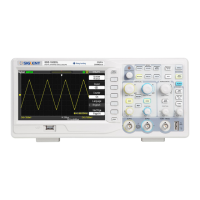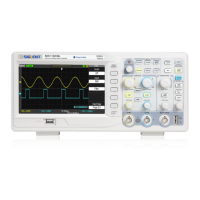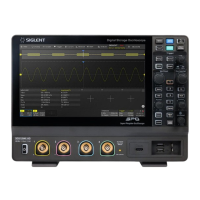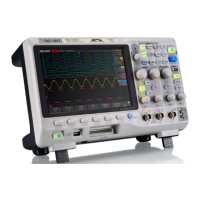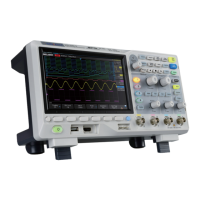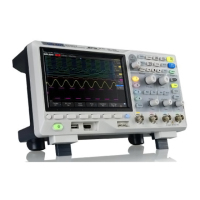Do you have a question about the SIGLENT SDS1102X and is the answer not in the manual?
Carefully read safety precautions to avoid personal injury or damage to the instrument.
Explains safety terms and symbols used in the manual and on the product.
Inspect shipping container, instrument, and accessories for damage or defects.
Shows front and top views of the oscilloscope with dimensions.
Instructions on adjusting supporting legs and connecting power supply.
Identifies and describes the numbered controls on the front panel.
Identifies and describes the connectors and features on the rear panel.
Details the functions of the horizontal and vertical controls on the front panel.
Explains the main display elements and labels of the oscilloscope interface.
Instructions on how to use the security lock hole on the oscilloscope.
Describes how to enable and use the analog input channels (CH1, CH2).
Explains how to adjust the vertical scale in Coarse or Fine mode.
Details how to adjust the vertical position of the waveform.
Explains how to set the coupling mode (DC, AC, GND) to filter signals.
Describes how to set the bandwidth limit to reduce display noise.
How to set the probe attenuation factor for correct vertical readouts.
Explains how to match channel input impedance for accurate measurements.
How to select the amplitude display unit (V or A) for the current channel.
Instructions on how to invert the display of a channel's waveform.
How to adjust the horizontal time base and sample rate.
How to adjust the trigger delay and position of the waveform.
Instructions on how to enter and use the roll mode for waveform display.
How to use the zoom function for detailed analysis of signals.
How to run, stop, or capture single acquisitions of the waveform.
Introduction to sampling theory, sample rate, and bandwidth.
Explains sample rate and its influence on waveform display.
Discusses the relationship between oscilloscope bandwidth and sample rate.
How to select the memory depth for storing waveform points.
Describes the real-time sampling mode of the oscilloscope.
How to choose between X and Sinx interpolation methods.
How to select the trigger source (analog channels, EXT, AC Line).
Explains Auto, Normal, and Single trigger modes.
How to adjust the trigger level for stable triggering.
Explains trigger coupling modes (DC, AC, LF Reject, HF Reject).
How to use trigger holdoff to stabilize triggering on complex waveforms.
How to turn on/off noise rejection to reduce triggering on noise.
Lists various trigger types available (Edge, Slope, Pulse, etc.).
Setup and usage for IIC signal triggering and decoding.
Setup and usage for SPI signal triggering and decoding.
Setup and usage for UART/RS232 signal triggering and decoding.
Steps to save reference waveforms to internal memory.
How to display saved reference waveforms on the screen.
How to adjust the vertical scale and position of reference waveforms.
Method to clear or overwrite reference waveform displays.
Table showing units for different math operations.
Explains Addition, Subtraction, Multiplication, Division, FFT operations.
How to adjust scale and offset for math waveforms.
How to use vertical cursors to measure time or frequency.
How to use horizontal cursors to measure voltage or current.
Explains voltage, time, and delay measurement parameters.
Steps to perform automatic measurements of voltage or time parameters.
How to clear displayed measurement parameters.
How to measure all available voltage, time, and delay parameters.
How to select between Vectors and Dots display types.
How to enable color temperature for waveform probability display.
How to set and clear persistence display modes.
How to clear all waveforms from the screen.
How to select different grid types for the display.
How to adjust the intensity of the displayed waveforms.
How to adjust the brightness of the display grid.
How to adjust the transparency of message boxes and pop-up menus.
Describes supported save types: setups, waveforms, pictures, CSV.
Procedures for saving and recalling settings to internal memory.
Procedures for saving and recalling to USB storage devices.
Operations for managing files and folders on external storage.
How to view system status like software version, serial number.
Steps to perform self-calibration for accurate measurements.
Configuration of USB and LAN interfaces for communication.
How to perform screen, keyboard, and LED self-tests.
How to enable or disable the beeper sound.
How to select the user interface language.
How to set up and perform pass/fail testing against a mask.
Steps to print the oscilloscope screen image via USB.
How to enable quick calibration for temperature compensation.
Instructions for updating firmware and configuration files.
How to set the time before the screen saver is enabled.
How to view installed options or activate new ones with a license.
How to record and replay waveforms using the history function.
How to select waveform type and set parameters like frequency, amplitude.
Steps to send arbitrary waveforms to the oscilloscope.
How to set the output load impedance (High-Z or 50Ω).
How to restore default values for the Wave Gen.
How to perform self-calibration for the Arbitrary Waveform Generator.
Carefully read safety precautions to avoid personal injury or damage to the instrument.
Explains safety terms and symbols used in the manual and on the product.
Inspect shipping container, instrument, and accessories for damage or defects.
Shows front and top views of the oscilloscope with dimensions.
Instructions on adjusting supporting legs and connecting power supply.
Identifies and describes the numbered controls on the front panel.
Identifies and describes the connectors and features on the rear panel.
Details the functions of the horizontal and vertical controls on the front panel.
Explains the main display elements and labels of the oscilloscope interface.
Instructions on how to use the security lock hole on the oscilloscope.
Describes how to enable and use the analog input channels (CH1, CH2).
Explains how to adjust the vertical scale in Coarse or Fine mode.
Details how to adjust the vertical position of the waveform.
Explains how to set the coupling mode (DC, AC, GND) to filter signals.
Describes how to set the bandwidth limit to reduce display noise.
How to set the probe attenuation factor for correct vertical readouts.
Explains how to match channel input impedance for accurate measurements.
How to select the amplitude display unit (V or A) for the current channel.
Instructions on how to invert the display of a channel's waveform.
How to adjust the horizontal time base and sample rate.
How to adjust the trigger delay and position of the waveform.
Instructions on how to enter and use the roll mode for waveform display.
How to use the zoom function for detailed analysis of signals.
How to run, stop, or capture single acquisitions of the waveform.
Introduction to sampling theory, sample rate, and bandwidth.
Explains sample rate and its influence on waveform display.
Discusses the relationship between oscilloscope bandwidth and sample rate.
How to select the memory depth for storing waveform points.
Describes the real-time sampling mode of the oscilloscope.
How to choose between X and Sinx interpolation methods.
How to select the trigger source (analog channels, EXT, AC Line).
Explains Auto, Normal, and Single trigger modes.
How to adjust the trigger level for stable triggering.
Explains trigger coupling modes (DC, AC, LF Reject, HF Reject).
How to use trigger holdoff to stabilize triggering on complex waveforms.
How to turn on/off noise rejection to reduce triggering on noise.
Lists various trigger types available (Edge, Slope, Pulse, etc.).
Setup and usage for IIC signal triggering and decoding.
Setup and usage for SPI signal triggering and decoding.
Setup and usage for UART/RS232 signal triggering and decoding.
Steps to save reference waveforms to internal memory.
How to display saved reference waveforms on the screen.
How to adjust the vertical scale and position of reference waveforms.
Method to clear or overwrite reference waveform displays.
Table showing units for different math operations.
Explains Addition, Subtraction, Multiplication, Division, FFT operations.
How to adjust scale and offset for math waveforms.
How to use vertical cursors to measure time or frequency.
How to use horizontal cursors to measure voltage or current.
Explains voltage, time, and delay measurement parameters.
Steps to perform automatic measurements of voltage or time parameters.
How to clear displayed measurement parameters.
How to measure all available voltage, time, and delay parameters.
How to select between Vectors and Dots display types.
How to enable color temperature for waveform probability display.
How to set and clear persistence display modes.
How to clear all waveforms from the screen.
How to select different grid types for the display.
How to adjust the intensity of the displayed waveforms.
How to adjust the brightness of the display grid.
How to adjust the transparency of message boxes and pop-up menus.
Describes supported save types: setups, waveforms, pictures, CSV.
Procedures for saving and recalling settings to internal memory.
Procedures for saving and recalling to USB storage devices.
Operations for managing files and folders on external storage.
How to view system status like software version, serial number.
Steps to perform self-calibration for accurate measurements.
Configuration of USB and LAN interfaces for communication.
How to perform screen, keyboard, and LED self-tests.
How to enable or disable the beeper sound.
How to select the user interface language.
How to set up and perform pass/fail testing against a mask.
Steps to print the oscilloscope screen image via USB.
How to enable quick calibration for temperature compensation.
Instructions for updating firmware and configuration files.
How to set the time before the screen saver is enabled.
How to view installed options or activate new ones with a license.
How to record and replay waveforms using the history function.
How to select waveform type and set parameters like frequency, amplitude.
Steps to send arbitrary waveforms to the oscilloscope.
How to set the output load impedance (High-Z or 50Ω).
How to restore default values for the Wave Gen.
How to perform self-calibration for the Arbitrary Waveform Generator.
| Bandwidth | 100 MHz |
|---|---|
| Sample Rate | 1 GSa/s |
| Channels | 2 |
| Memory Depth | 14 Mpts |
| Vertical Resolution | 8 bits |
| Display Resolution | 800 x 480 |
| Power Supply | 100-240 VAC, 50/60 Hz |
| Display | 7 inch TFT LCD |
| Waveform Capture Rate | 100, 000 wfms/s |
| Interfaces | USB, LAN |
| Math Functions | +, -, *, /, FFT |
| FFT Window | Rectangle, Blackman, Hanning, Hamming |
| Trigger Types | Edge, Pulse, Video, Slope |




